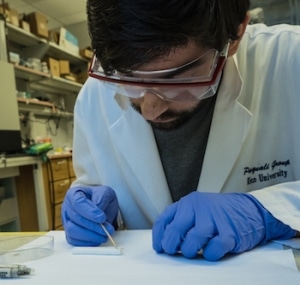Oct 24 2017
According to researchers at Rice University, fibers composed of carbon nanotubes configured as wireless antennas can be as good as copper antennas but 20 times lighter.
 Rice University graduate student Amram Bengio sets up a nanotube fiber antenna for testing. Scientists at Rice and the National Institute of Standards and Technology have determined that nanotube fibers made at Rice can be as good as copper antennas but 20 times lighter. (Photo by Jeff Fitlow)
Rice University graduate student Amram Bengio sets up a nanotube fiber antenna for testing. Scientists at Rice and the National Institute of Standards and Technology have determined that nanotube fibers made at Rice can be as good as copper antennas but 20 times lighter. (Photo by Jeff Fitlow)
The antennas may offer useful advantages for aerospace applications and wearable electronics where flexibility and weight are vital factors.
The research findings have been published in Applied Physics Letters.
The discovery provides more potential applications for the robust, lightweight nanotube fibers developed by the Rice lab of Chemist and Chemical Engineer Matteo Pasquali. The lab introduced the first practical technique for developing high-conductivity carbon nanotube fibers in 2013 and has since analyzed them for use in heart surgeries and as brain implants, among other applications.
The research could help Engineers who strive to simplify materials for spacecraft and airplanes where weight equals cost. Greater interest in wearables like wrist-worn health monitors and clothing with embedded electronics could benefit from strong, flexible and conductive fiber antennas that transmit and receive signals, Pasquali said.
The Rice team and colleagues at the National Institute of Standards and Technology (NIST) developed a metric they refer to as “specific radiation efficiency” to review how well nanotube fibers radiated signals at the typical wireless communication frequencies of 1 and 2.4 gigahertz and compared their results with regular copper antennas. They made thread composed of eight to 128 fibers that are nearly as thin as a human hair and cut to the same length to test on a custom rig that made direct comparisons with copper practical.
Antennas typically have a specific shape, and you have to design them very carefully. Once they’re in that shape, you want them to stay that way. So one of the first experimental challenges was getting our flexible material to stay put.
Amram Bengio, Rice Graduate Student and the Paper’s Lead Author
Contrary to former results by other labs (which used various carbon nanotube fiber sources), the Rice team found the fiber antennas corresponded with copper for radiation efficiency at the same diameters and frequencies. Their results support theories that estimated the performance of nanotube antennas would scale with the conductivity and density of the fiber.
“Not only did we find that we got the same performance as copper for the same diameter and cross-sectional area, but once we took the weight into account, we found we’re basically doing this for 1/20th the weight of copper wire,” Bengio said.
“Applications for this material are a big selling point, but from a scientific perspective, at these frequencies carbon nanotube macro-materials behave like a typical conductor,” Bengio added. Even fibers considered “moderately conductive” exhibited excellent performance, he said.
Although manufacturers could basically use thinner copper wires instead of the 30 gauge wires they presently use, those wires would be very delicate and hard to handle, Pasquali said.
Amram showed that if you do three things right — make the right fibers, fabricate the antenna correctly and design the antenna according to telecommunication protocols — then you get antennas that work fine. As you go to very thin antennas at high frequencies, you get less of a disadvantage compared with copper because copper becomes difficult to handle at thin gauges, whereas nanotubes, with their textile-like behavior, hold up pretty well.
Matteo Pasquali, Chemist and Chemical Engineer
Co-authors of the paper are, from Rice, Graduate Students Lauren Taylor and Peiyu Chen, Alumnus Dmitri Tsentalovich and Aydin Babakhani, an Associate Professor of Electrical and Computer Engineering, and, from NIST in Boulder, Colo., Postdoctoral Researcher Damir Senic, Research Engineer Christopher Holloway, Physicist Christian Long, Research Scientists David Novotny and James Booth and Physicist Nathan Orloff. Pasquali is a Professor of Chemical and Biomolecular Engineering, of Materials Science and Nanoengineering and of Chemistry.
The research was supported by the U.S. Air Force.